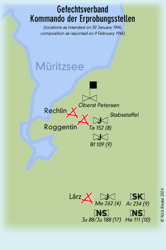
|
The closing months of the war saw Germany constantly scraping together makeshift formations in the hope of somehow keeping fighting. In the Luftwaffe, one such was the Gefechtsverband Kommando der Erprobungsstellen (Battle Unit of the Trials Establshments Command). The first intimation of this measure recieved by the Allies came in a message of 23 January 1945 from a Maj. Großholz of Erprobungsstelle Rechlin advising that the “surrender at short notice” of operationally serviceable aircraft of the following types was a possibility: the Bf 109, Fw 190, Ar 234, Me 262, Ju 88, “8-108” (almost certainly an error for “8-188”) and He 111 H-6. Accordingly, they should only carry out test flights with full operational armament and bomb-dropping, altitude and radio equipment, so long as this did not impede the tests being undertaken. Lists of aircraft available should be presented at the commander’s conference in Rechlin two days hence. On the 30th, KdE was advising the General Staff that the organisation plan had been amended, replacing with E.-Kdo. Ta 152 with Stabsstaffel JG 301, subordinated to that Geschwader for operations. A telegram the following day called for preparations to be made in case the situation on the ground halted the testing programme; if that happened, the usable aircraft and their pilots must be ready to operate against the enemy. Receipt of the codeword “Gneisenau” would trigger the immediate establishment of Gefechtsverband KdE in Rechlin with all operationally ready Me 262, Ar 234, Bf 109, Fw 190, Ta 152, Ju 88, Ju 188 and He 111 aircraft and crews in the experimental establishments. The intended set up was:
Petersen was to appoint Staffelführer from amongst the personnel of the experimental establishments. Rechlin issuing the codeword “Blücher” would mean that the operationally useable aircraft were to be transferred there or to Lärz along with their aircrew and chief mechanics and to report to their nominated Staffelführer. Operationally-ready aircrew for whom there were no machines should be sent off to Rechlin, followed as quickly as possible by any aircraft which could subsequently made serviceable. Expected strength should be reported to the command post within two hours. Staffeln should also report whether they could be reached by telephone or runner. Rechlin would be responsible for all supplies and servicing (with about 20–30 groundcrew per Staffel except for the Ta 152 and reserve units). Vehicles allotted were a Kettenkrad half-track motorcycle, one car and two lorries along with any available vehicles suitable for towing aircraft). Bombs and ammunition should be taken from the stocks to hand and the same applied for fuel. Orders were relayed on 31 January to all the Erprobungsstellen, referring to discussions at a conference on the 25th. Everyone was to report the expected strength of the units they were to raise. It was "of decisive significance” that aircraft bring their own bombs. On 3 February Luftflotte 6 was notified of aircraft that could be made available from various home establishments in the 1. Jagd Division area for operations on the Eastern Front. The Kommando der Erprobungsstellen could offer:
In its weekly report dated 27 January, Rechlin was able to advise, the folowing Ar 234s could be declared capable of operations at the front after minor adaptations: Werk Nummern 140102, 140106, 140107, 140114, 140150 and 140160 They were equipped, variously, with BZA 13, BZA 3, TSA 2D and Lotfe bomb sights. By 9 February a Maj. Bader was able to report that, in accordance with a Führungsstab order of the 1st a Gefechtsverband had been established as follows, distributed between Rechlin and its satellites, Roggenthin and Lärz (note the different figures):
National Archives, Kew, London HW 5/651: CX/MSS/T438/47 HW 5/661: CX/MSS/T457/39 Bundesarchiv-Militärarchiv, Freiburg-im-Breisgau RL 2-III/45: Aufstellung, Umbildung, Umbenennung und Auflösung.- Sammlung von Verfügungen, Dienstanweisungen, Organisationsplänen und Geschäftsverteilungsplänen, Band 23 (Januar–Februar 1945) RL 3/2572: Chef TLR Anlagen zum Kriegstagebuch, Band 5 (1944–1945) RL 3/2574: Chef TLR Anlagen zum Kriegstagebuch, Band 7 (1944–1945) RL 7-6/11: Luftflotte 6, Anlagen zum Kriegstagebuch, Band 4 (Februar 1945) |
||||||||||||||||||||||||||||||||||||||||||||||||||||||||||||||||||||||||||||||||||||||||||||||||||||||||||||||||||||||||||||||||||||||||||
A composite Luftwaffe unit formed in response to the multiplying crises of 1945 (click on the map to enlarge it):
|
|||||||||||||||||||||||||||||||||||||||||||||||||||||||||||||||||||||||||||||||||||||||||||||||||||||||||||||||||||||||||||||||||||||||||||
© Nick Beale 2024 |
|||||||||||||||||||||||||||||||||||||||||||||||||||||||||||||||||||||||||||||||||||||||||||||||||||||||||||||||||||||||||||||||||||||||||||
